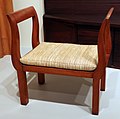Edward Wormley
Edward J. Wormley (born December 31, 1907 in Oswego (Illinois) , † November 3, 1995 in Norwalk (Connecticut) ) was an American furniture designer .
Life
Tree filer from 1947 (Dunbar model number 4765), Milwaukee Art Museum
Wormley was the son of Edith and Myron J. Wormley. He moved to Rochelle, Illinois with his parents when he was two years old . As a child he suffered from polio , could only walk from the age of five and was unable to walk all his life. During his school days, he took correspondence courses at the New York School of Interior Design . With his future partner Edward Crouse he played at the theater of Rochelle Township High School .
Wormley studied for three semesters at the Art Institute of Chicago in 1926 . After he ran out of funds, he worked as an interior designer for the department store Marshall Fields & Company , which sent him after two years to the furniture manufacturer of the Berkey & Gay Furniture Company in Grand Rapids (Michigan) . However, his designs there never got into production because of the global economic crisis , as he was laid off after a year and the company went bankrupt. In 1930 he traveled to Paris , where he met the architect Le Corbusier and the Art Deco designer Jacques-Émile Ruhlmann .
Wormley's former supervisor at Marshall Field introduced him to Homer Niederhauser, President of the Dunbar Furniture Company , in 1931 in Berne, Indiana , who offered him a position as a furniture designer. Wormley accepted and settled in Chicago, where Dunbar had one of his main showrooms. Here he designed two to four product lines each year, each with 20 to 25 pieces of furniture. He also worked as a freelance designer and consultant for companies such as Rand McNally , Lightolier and Macy's Department Store . With Edward Crouse, he toured Europe , the West Indies , Mexico and the United States .
In the early 1940s, Wormley was well known in the furniture industry. His designs received critical acclaim and sold well. 1942 Wormley headed the furniture department in the Office of Price Administration in Washington, DC , a Commission with a focus on price stability and consumer protection, the Council on National Defense ( German Council for National Defense ) advised during World War II.
After the war, Wormley moved to New York City and opened his company Edward Wormley and Associates , keeping Dunbar as his main customer. In addition to his commercially successful furniture designs for Dunbar (including the Janus product line from 1957, which comprised 70 items), this enabled him to carry out major renovation projects for private customers. In 1946 he brought his friend Edward Crouse, who was professor of journalism and theater director at the University of Georgia from 1930 to 1946 , as a designer and draftsman in his company, where he worked until his retirement. Wormley gave numerous lectures and taught from 1955 at Parsons The New School for Design .
Wormley and Crouse bought a country house in Weston, Connecticut , where they lived from 1968. They traveled together until Crouse died of cancer in 1975. After the death of his partner, Wormley withdrew, still traveled occasionally, and passed away in 1995.
plant
From 1944 onwards, Wormley's work for Dunbar Furniture Company went without exception in the style of the mid-century modern . To this end, Wormley incorporated the design of European and especially Scandinavian furniture. Wormley was not a leading designer of his time, but took the best elements of classic, historical design and carried them over to the modern age, creating sophisticated furniture that was nonetheless mainstream and very successful. Among other things, he made furniture with Dunbar, which was based on the work of Richard Riemerschmid and Jean-Michel Frank . His products were of high quality and were perceived as elegant and unobtrusive. Wormley understood the essential elements of modernity, but was not only true to one direction. Historical design and the innovations of the 20th century that still appeal to collectors today came together in his furniture.
Side tables from the Janus series were created in 1957 in collaboration with Tiffany and the ceramic artist Otto Natzler .
Other works were (selection):
- Armchair teardrop
- Chaise longue Listen-to-me
- Sofa tete-a-tete
Wormley's work was shown in the Good Design Exhibitions of the Museum of Modern Art in 1951 and 1952 , while others were included in the collections of the Museum of Fine Arts, Boston and the Museum of Decorative Arts, Montreal .
Publications
- Berne, Indiana. Dunbar Furniture Corporation, 1956.
- Edward Wormley. The Other Face of Modernism. Lin-Weinberg Gallery, New York 1997
literature
- Leslie Pina: Dunbar. Fine Furniture of the 1950s. Schiffer Publishing, 1999, ISBN 978-0-76431-053-9 , 212 pp.
- Marie Ferran-Wabbes: Edward J Wormley, 1907-1995. Le designer des furniture Dunbar. Marie Ferran-Wabbes, 2017, ISBN 978-1-54267-338-9 , 103 pp.
Web links
- Edward J Wormley and Edward Crouse Papers, 1931-1997 (bulk 1907-1997). Collection Number 7684. In: Cornell University , Ithaca (New York City)
- Rita Reif: Edward Wormley, 87, Designer Of Modern Residential Furniture. In: The New York Times, November 8, 1995.
- Edward Wormley (American, 1907-1995). In: artnet , with pictures of Wormley's work
Individual evidence
- ^ Oscar P. Fitzgerald: American Furniture. 1650 to the Present. Rowman & Littlefield, 2017, ISBN 978-1-44227-040-4 , p. 289.
| personal data | |
|---|---|
| SURNAME | Wormley, Edward |
| ALTERNATIVE NAMES | Wormley, Edward J. |
| BRIEF DESCRIPTION | American furniture designer |
| DATE OF BIRTH | December 31, 1907 |
| PLACE OF BIRTH | Oswego (Illinois) |
| DATE OF DEATH | November 3, 1995 |
| Place of death | Norwalk (Connecticut) |


